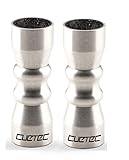The mechanical bridge is a helpful tool for those hard to reach shots in pool.
These bridges are very easy to use. Yet many players, especially beginners, prefer to stand on their tippy-toes and stretch out as far as possible. But there is no need to extend your reach this far.
Once you learn how to use a mechanical bridge properly, you can comfortably reach over one or several object balls and make a precise shot.No stretching necessary.
What is a Mechanical Bridge?
A mechanical billiards bridge is a pool cue with a notched attachment (known as a “bridge head”) at the end.
Think of it as an extension of your normal bridge hand when a shot is beyond a comfortable reach.
A classic bridge head has six grooves where you can place a cue. There are three on the top, one on each side, and a shallow “v” on the bottom.
We’ll explain how to use these grooves in a bit.
Other bridge heads have different configurations with more notches to place the cue.
With up to 9 notches, these are known as “moosehead” bridge heads because they look like antlers.
There are several other bridge head designs that players use in different situations. Two popular designs are the cross head and spider head.
The cross head is great for quick use of a mechanical bridge with firm and solid cue placement.
This is basically an X at the end of your pool cue. You place the cue right in the notch on any side. Like most bridgeheads, it includes rubber on the ends to protect the table felt.
The spider head is similar to the traditional design with higher “legs”.
It has three notches to place the cue on top. These are great when you have to reach over more than one ball, or want to shoot down on the cue with more leverage.
Bridge heads can be made of metal (i.e. copper or aluminum), molded plastic with protective rubber, wrapped in leather, wood or other materials.
Some bridge heads are designed to screw on to different pool cues for portability, while others are fastened to the end of a mechanical bridge stick.
When to use a mechanical bridge
You should use a mechanical bridge whenever the cue ball is beyond your comfortable reach.
For example, if you are stretching out and it’s hard to properly set your normal bridge hand on the table, then it’s time to use the bridge stick.
This is often the case when you use an open bridge and are unable to firmly cup your hand on the table.
Or, there might be an object ball in front of the cue ball. When you try to shoot over the ball without touching it, your bridge becomes shaky and unstable.
You’ll notice that advanced players sometimes use modified hand bridges with hard to reach shots. They make it look easy; like there’s no need to use another stick to reach the shot.
But this should only be done when you’re sure you can still cleanly execute the shot without fouling. For most of us, extending beyond our comfort zones results in sloppy play and poor results.
How to Use a Mechanical Bridge
Here are 10 steps to follow when it’s time to break out the mechanical bridge.
- Lay the bridge cue flat on the table.
- Place the bridge cue so the bridgehead is about 6 – 8 inches from the cue ball. You want to be close to the cue ball, but far enough to allow for a smooth stroke.
- Hold the bridge cue firmly on the table with your non-shooting hand. The bridge cue should be to the left side of your shooting cue (if right-handed).
- Take your shooting cue and place the shaft in one of the notches on the bridge head. Placing the cue in the lower notch is best when you are trying to draw or stop the cue ball. Placing in a higher notch is better when you want the cue ball to “follow”.
- If there are a few object balls and you need extra height, place the bridge head on its side, and use a side notch.
- Hold your pool cue at the butt of the cue. The thumb should be placed under the base of the cue. Lay your other four fingers over the top. Your shooting elbow should stick out to the side.
- Use your wrist and fingers to stroke the cue (rather than your elbow).
- Make sure you do not touch the cue ball or any other object ball before you shot. This would be a foul in any billiards game, including 8-ball or 9-ball.
- Use a smooth and deliberate stroke.
- Remember to follow through, just as with any stroke.



